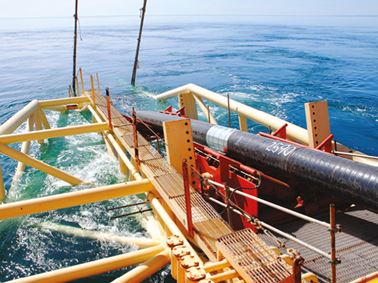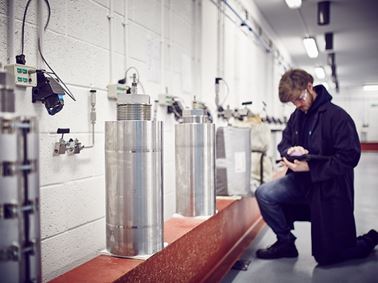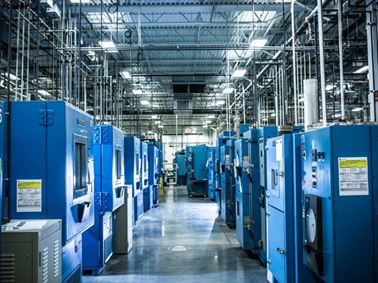Sulfide Stress Cracking (SSC) testing helps evaluate your materials and detect danger at an early stage, preventing failure of sour service pipelines. Often occuring without warning and only observable using specialized inspection methods, this dangerous type of corrosion produces some of the toughest technical challenges for Oil & Gas and Petrochemical manufacturers. Trust Element’s expert-led assessments and timely solutions - fully compliant with NACE TM0177/ISO 15156 standards - to ensure the longevity and reliability of your infrastructure.
What is Sulfide Stress Cracking (SSC) Testing?
As a form of hydrogen stress cracking, SSC is a cracking mechanism in pipelines, facilities piping and any equipment that encounters sour (wet H2S) service conditions. It is characterized as the cracking of a metal when subjected to the combined effects of tensile stress and corrosion in the presence of water and hydrogen sulfide. Testing for sulfide stress cracking helps to evaluate your materials and detect danger at an early stage, preventing the failure of sour service pipelines and ensuring their reliability and longevity.
Benefits of Sulfide Stress Cracking Testing at Element
- Meet Regulatory Compliance: Our SSC testing services comply with NACE MR0175/ISO 15156, and EFC and align with various specific industry standards and regulatory requirements.
- Expertise in Harsh Environments: Assess your materials for SSC resistance in HPHP conditions and exposure to corrosive substances.
- Global Presence: Our global reach of laboratories supports your diverse geographical operations.
- Diverse Material Coverage: Comprehensive materials testing for pipelines, well components and exploration and refining equipment, including carbon steels, low-alloy steels and Corrosion Resistant Alloys (CRAs).
- Non-Destructive Testing (NDT) Excellence: Minimize your operational disruptions with our NDT test methods such as ultrasonic testing and magnetic particle testing services.
- Timely and Cost-effective Approach: Efficient testing processes to support your tight deadlines and budget constraints.
- Collaborative Risk Management: Partnership in developing and implementing effective risk management strategies associated with SSC in your infrastructure.
- Tailored Testing for Diverse Industries: Customized solutions to meet your specific project needs and unique industry challenges.
- Advice and Guidance: Our corrosion experts provide recommendations for materials selection, coatings, and other measures to enhance SSC resistance and mitigate challenges.
Identify and Mitigate Potential Risks of SSC
Sulfide Stress Cracking is a dangerous type of corrosion which produces some of the toughest technical challenges for Oil & Gas and Petrochemical manufacturers. It often occurs without warning and it can only be observed using specialized inspection methods. At Element, we prioritize your asset protection, offering comprehensive solutions to address potential SSC risks and ensure the longevity of your infrastructure. Recognizing the urgent need to assess material sustainability, our experts proactively identify and mitigate the evolving risks of SSC, providing you with peace of mind and reliable asset longevity.
Comprehensive SSC Testing and Capabilities
- Hydrogen-induced cracking (HIC)
- Stress-oriented hydrogen-induced cracking (SOHIC)
- Sour Service applications – NACE TM0177, NACE TM0316, EFC 16 and EFC 17
- NDT testing and inspection
- Four Point bend test
- C-ring test
Residual Stress Full Ring Testing (FRT) / Ovalisation Test
Element offers full ring testing, also known as Ovalisation test, on pipe material from 2 inch (50 mm) up to 60 inch (1524 mm) diameter according to BS 8701 (formally OTI 95-635). Tests can be conducted on parent material or welded pipe (SAW/seam, spiral and/or girth) with the corrosive environment in contact with the bore or out of diameter (OD). The full pipe section is loaded to the required stress and exposed for a 30 day period after which the sample is examined for evidence of SSC, HIC, SOHIC and Soft-Zone Cracking. The inclusion of in-situ ultrasonic inspection and hydrogen permeation during the test enhances the comprehensiveness of the testing approach.
Axially Loaded Full Ring Test (AFRT)
Element has developed the Axially Loaded Full Ring Test (AFRT) method, specifically designed for SSC testing of parent welded pipes under high axial loads in service. This innovative approach includes a 30-day exposure period and examination for evidence of various forms of cracking, accompanied by in-situ ultrasonic inspection and hydrogen permeation.
Why Choose Element?
Element has a global network of ISO 17025-accredited corrosion testing laboratories located across the US, Europe, the Middle East and Asia.
We offer comprehensive sulfide stress cracking and sour service materials qualification testing services in accordance with NACE MR0175/ISO 15156 as well as industry specifications and requirements.
With over a decade of experience in providing corrosion testing services, we’ve supported a diverse range of industries, including Oil and Gas, Petrochemicals, pipeline operators and many more.
Combining industry experience with state-of-the-art laboratory testing and simulation facilities worldwide, we can simulate and evaluate the reaction of your materials under standard sour conditions or specific field conditions.
Find out more about Element and our credentials within the testing, inspection, and certification industry. For more information about how we perform Sulfide Stress Cracking (SSC) Testing, or to request a quote, contact us today.
FAQ: What is Hydrogen Embrittlement?
Discover hydrogen embrittlement as Vikram Nanda, an expert in metallurgy and metallurgical failure analysis, provides answers to commonly asked questions in this article.
Read MOREFracture Mechanics in the Environment (in-situ)
Learn more about the detrimental effect of Cathodic Protection, CO2, and H2S or other environmental parameters on fracture toughness of carbon steel pipe material.
Read MorePredicting component life with corrosion modeling
Erosion within oil and gas pipelines is a serious problem. Corrosion modeling using the Computational Fluid Dynamic method can accurately predict the location of burn-throughs.
Read MoreRelated Services

Hydrogen Induced Cracking (HIC) Testing
Element’s HIC tests evaluate material susceptibility to hydrogen induced cracking in a sour environment in accordance with NACE TM0284.

Stress Corrosion Cracking (SCC) Testing
Element’s Stress Corrosion Cracking (SCC) testing evaluates the susceptibility of metals to cracking failure under tensile stress and corrosion.

Energy Coatings Testing
We offer world-class materials expertise in polymers, elastomers, thermoplastics, composites and structural adhesives.

High Pressure High Temperature (HPHT) Testing
Element offers an advanced HPHT testing program for polymers, metals, coatings and components used in highly aggressive environments.

Climatics and Environmental Simulation
Element can provide you with critically important data on your product or part's performance in response to typical or extreme environmental conditions.

Liquid and Gas Permeation Testing for Polymers
Our unique range of permeation testing services determine the permeation coefficient (permeability), diffusion coefficient (diffusivity) and solubility coefficients.


